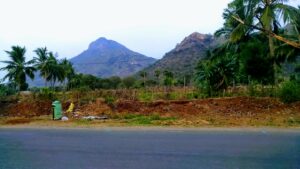
Tiruvannamalai is called Then Kailaayam (South Kailash) because Lord Shiva’s abode is Kailash and He is in the form of Arunachala Hill in Tiruvannamalai. It is the capital of saivism.
Tiruvannamalai is one of the Pancha Bhootha Sthalas. In Sanskrit, pancha means five, bhootha means basic element and sthala means sacred place. Each bhootha has an associated Shiva temple which are located in Kanchipuram for Earth element, Thiruvanaikaval for Water element, Tiruvannamalai for Fire element, Kalahasthi for Wind element and finally Chidambaram for Ether (Akash) element.
There are four cities giving Moksha (liberation) namely Tiruvarur, Chidambaram, Kasi and Tiruvannamalai. The following Sanskrit sloka (verse) beautifully explains this:
Darshanaath-aprasi-dasi Jananath-kamala-laye |
Kaasyandu-maranan-mukti Smaranath-arunachale ||
The meaning of the sloka: One gets liberated if they get the darshan of Chidambara Rahasya or born in Tiruvarur or die in Kasi. All these three may not be possible for everyone but one gets liberated with a mere thought of Arunachala. Such is the greatness of Tiruvannamalai.
No wonder, the great saints like Mahaan Sri Seshadri Swamigal and Bhagavan Sri Ramana Maharishi were attracted to this place and made it their home. Many saints, siddhas and yogis are believed to be still living in Tiruvannamalai. Out of eighteen important siddhas, one named Idaikaadar belongs to Tiruvannamalai.
Arunachala Hill is itself a Shivalinga.
Legendary story goes like this: Once there was a dispute between Brahma and Vishnu regarding who was greater. As Brahma is the lord of creation and Vishu is the lord of preserving, their quarrel brought chaos in the Universe. Devas approached Lord Shiva to settle their dispute and maintain peace in the Universe.
Shiva manifested himself as a column of light (Jyothi) from which a voice gave the challenge to Brahma and Vishnu that whoever could find its upper or lower end was greater. Immediately, Brahma took the form of a swan and started soaring up to reach the summit. Vishnu took the form of a pig and started digging the earth to find the lower end.
After sometime, Vishnu felt that he failed to reach the lower end of the column but started seeing the Divine Light which is pervading in everyone’s heart and thus He lost himself in deep meditation forgetting about everything. But, Brahma saw the flower of an Alse plant (called Thazhampoo in Tamil) falling through the air and thought of winning the challenge by deception. He returned with it and declared that he had plucked from the summit. On hearing the lie of Brahma, Jyothi exploded and a part of it fell in the present Tiruvannamalai and became a hill. Finally, Vishnu admitted his failure and Brahma confessed the lie. Thus Lord Shiva manifested himself as a hill for the benefit of mankind. Every year, a light beacon was lit during the star of karthika in the month of Vrischika (15 Nov – 15 Dec) to represent this legend.
Lord Shiva in the form of Jyoti, Brahma as swan, Vishnu as pig and the alse plant’s flower that gave false witness are carved in the back side of every Shiva temple called Lingotbavar to denote that Tiruvannamalai is the capital of Saivism.
Geological experts usually divide rocks into four types. They had confirmed that this mountain is an igneous rock. This mountain is called Arunachala because Aruna means Sun (Jyoti) and Achala means mountain.
This hill is about 167.44 meter high from the sea level. It is situated in 12.5 degree latitude and 79 degree longitude. The height of this mountain is about 2665 ft.
The layout of the city is an octagonal shape. One can find shivalinga temple in every direction in the name of Ashta Dikbalas (Lord of eight directions). As per the legendary story, when Jyoti fell on the earth of present Tiruvannamalai, Ashta Dikbalas came to see the Lord on the earth.
The perimeter of the hill is 8 miles. While doing giri pradakshina, one can see Lord Nandi statue in those eight directions facing the mountain. Usually Nandi can be seen facing shivalinga. This also confirms that the hill is shivalinga. One can see different peaks of hill while going around. Each denotes oneness for one peak, Ardha Nareeswara for two peaks, Trimurthis for three peaks and finally five peaks (called Pancha Mukham) for the five faces of Lord Shiva.
There are many temples and water sources on top of the hill including Ramana Maharishi’s Kandaasram and Ramana Theertham.
Karthika Deepam is one of the important old festival celebrated in Tiruvannamalai for about 10 days. When Brahma and Vishnu failed to find the upper and lower ends of the Jyoti, Lord Shiva told Devas that He will come to Tiruvannamalai during every Karthika star of Karthika month. On this day, Goddess Parvati became part of Shiva and hence He was called as Ardha Nareeswara.
Please watch following video in which the Saint Poojyasri R. Muthukumaraswamy Ayya who is also the President & Secretary of Seshadri Swamigal Ashram explaining the greatness of Karthika Deepam: